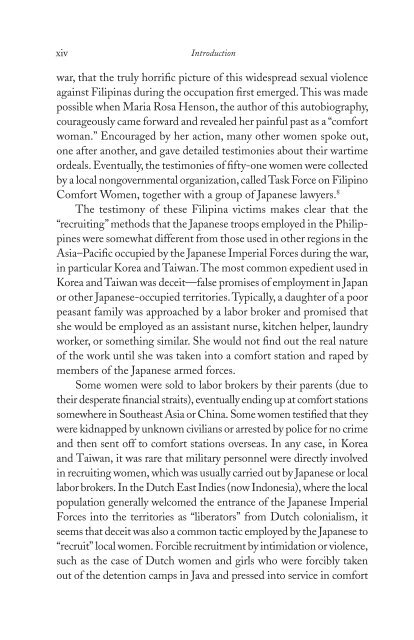Comfort Woman : a Filipina's Story of Prostitution and Slavery Under ...
Comfort Woman : a Filipina's Story of Prostitution and Slavery Under ...
Comfort Woman : a Filipina's Story of Prostitution and Slavery Under ...
You also want an ePaper? Increase the reach of your titles
YUMPU automatically turns print PDFs into web optimized ePapers that Google loves.
xiv<br />
Introduction<br />
war, that the truly horrifi c picture <strong>of</strong> this widespread sexual violence<br />
against Filipinas during the occupation fi rst emerged. This was made<br />
possible when Maria Rosa Henson, the author <strong>of</strong> this autobiography,<br />
courageously came forward <strong>and</strong> revealed her painful past as a “comfort<br />
woman.” Encouraged by her action, many other women spoke out,<br />
one after another, <strong>and</strong> gave detailed testimonies about their wartime<br />
ordeals. Eventually, the testimonies <strong>of</strong> fi fty-one women were collected<br />
by a local nongovernmental organization, called Task Force on Filipino<br />
<strong>Comfort</strong> Women, together with a group <strong>of</strong> Japanese lawyers. 8<br />
The testimony <strong>of</strong> these Filipina victims makes clear that the<br />
“recruiting” methods that the Japanese troops employed in the Philippines<br />
were somewhat different from those used in other regions in the<br />
Asia–Pacifi c occupied by the Japanese Imperial Forces during the war,<br />
in particular Korea <strong>and</strong> Taiwan. The most common expedient used in<br />
Korea <strong>and</strong> Taiwan was deceit—false promises <strong>of</strong> employment in Japan<br />
or other Japanese-occupied territories. Typically, a daughter <strong>of</strong> a poor<br />
peasant family was approached by a labor broker <strong>and</strong> promised that<br />
she would be employed as an assistant nurse, kitchen helper, laundry<br />
worker, or something similar. She would not fi nd out the real nature<br />
<strong>of</strong> the work until she was taken into a comfort station <strong>and</strong> raped by<br />
members <strong>of</strong> the Japanese armed forces.<br />
Some women were sold to labor brokers by their parents (due to<br />
their desperate fi nancial straits), eventually ending up at comfort stations<br />
somewhere in Southeast Asia or China. Some women testifi ed that they<br />
were kidnapped by unknown civilians or arrested by police for no crime<br />
<strong>and</strong> then sent <strong>of</strong>f to comfort stations overseas. In any case, in Korea<br />
<strong>and</strong> Taiwan, it was rare that military personnel were directly involved<br />
in recruiting women, which was usually carried out by Japanese or local<br />
labor brokers. In the Dutch East Indies (now Indonesia), where the local<br />
population generally welcomed the entrance <strong>of</strong> the Japanese Imperial<br />
Forces into the territories as “liberators” from Dutch colonialism, it<br />
seems that deceit was also a common tactic employed by the Japanese to<br />
“recruit” local women. Forcible recruitment by intimidation or violence,<br />
such as the case <strong>of</strong> Dutch women <strong>and</strong> girls who were forcibly taken<br />
out <strong>of</strong> the detention camps in Java <strong>and</strong> pressed into service in comfort

















